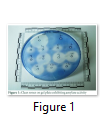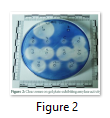Full Length Research Article
Detection of Human Salivary Amylase Level Deposited on Fruits with First Bite Mark
Umar Draz1,*, Saadat Ali1, Sehrish Firyal1, Ahmad Ali2, Ali Haider Saleem3, Mohammad Ashraf Tahir4
Adv. life sci., vol. 6, no. 4, pp. 176-181, August 2019
*- Corresponding Author: Umar Draz (Email: umardraz199@gmail.com)
Authors' Affiliations
2. National Institute for Genomics and Advanced Biotechnology, National Agricultural Research Centre (NARC), Islamabad, Pakistan
3. Department of Animal Sciences, College of Veterinary and Animal Sciences, Jhang, Pakistan
4. Punjab Forensic Science Agency, Lahore, Pakistan
Abstract![]()
Introduction
Methods
Results
Discussion
References
Abstract
Background: Human body fluids are vital for criminological examinations. The recovery, conservation, and investigation of body fluids or its stains are critical in measurable forensic cases. The amylase testing is being utilized as a possible test to locate the crime scene saliva stains for more than three decades. This investigation was intended to decide the human salivary amylase accumulated on fruit after the first bite where the level of salivary amylase was concluded by Radial Gel Diffusion method.
Methods: Three sorts of organic fruits (apple, peach, and apricot) and 20 people (10 male and 10 female) were chosen for this investigation. The specimens were assembled from bite mark area following time intervals 0 hours, 12 hours, 24 hours, 36 hours and 48 hours.
Results: Experimental outcomes demonstrated that the diameter of amylase activity in male specimens was more noteworthy than female. Apples, as well as apricot pit samples, indicated amylase activity till 48 hours; however, the specimens collected from peach demonstrated amylase activity until 12 hours, after first bite mark.
Conclusion: This study demonstrated that salivary amylase testing might be valuable for DNA evidence, where DNA investigations for every case might be restricted because of cost issues.
Keywords: Amylase; Saliva; Investigation; Bite mark; Preservation
Authentication of body fluids at a crime scene is the basic of criminological science. Now and again, simply identifying the uniqueness of a liquid can be sufficient to impact the result of a case. Body fluid traces recuperated at crime scenes contain important confirmations that can distinguish a casualty or suspect and vindicate an innocent. Blood, semen, saliva, etc. are the well-known body fluids found at crime scenes yet others, for example, vaginal secretions and urine can likewise assume vital as all contain evidence in the form of DNA [1]. Almost all these body-liquids have one or more screening assays that are presumptive in nature, and some of them have confirmatory assays to undeniably perceive their existence [2].
The forensic detection of human saliva can be a capable tool in the examination of a crime scene [3]. In sexual assault cases, the incidence of human salivation can prompt a DNA profile from a suspect, as epithelial cells found inside saliva are a potential resource of DNA [4,5]. In legal examinations, saliva screening utilizing amylase has been employed as a presumptive test, mainly to locate saliva stains on multiple surfaces [6]. Amylase, a starch-digesting enzyme is detected in almost all life forms; however, they are assorted in specificity, activity, and necessity from tissue to tissue and species to species and present in high fixations within human saliva [7].
In humans, two principal isozymes of alpha-amylase exist i.e. salivary alpha-amylase plus pancreatic alpha-amylase. Both alpha-amylases have been recognized in a wide range of body liquids [8]. Salivary alpha-amylase is available in a higher congregation in saliva while in lower fixation in perspiration and breast milk and encoded by AMY1 gene whereas pancreatic alpha-amylase is available in a higher congregation in blood while in lower fixation in semen and vaginal oozing and encoded by AMY2 gene [2]. Instantly, a screening strategy in light of amylase testing could be valuable to bring down the quantity of negative DNA tests from crime scenes.
Radial gel diffusion that relies upon amylase activity can be broadly acknowledged for identification of salivary amylase [9,10]. In it, the specimen is nurtured in starch restraining agarose gel to permit amylase activity to proceed after the addition of iodine. The permutation of starch and iodine makes a characteristic blue color that is associated with the negative control and therefore a positive reaction is pointed out by the desertion of color. Being nondamaging test, radial gel diffusion is an imperative procedure which could be utilized for the semi-quantitative manifestation of routine saliva cases, in forensic agencies of Pakistan such as Punjab Forensic Science Agency (PFSA) and National Forensic Science Agency (NFSA), etc.
Though, the detection of amylase from fruit bites is a common practice and very well reported, but data reported here will assist in the selection of a biological specimen/ fruit type that is more probative in a time-dependent manner i.e. after 0 hours, 12 hours, 24 hours, 36 hours and 48 hours and ultimately reduce the number of specimens which made this study novel and thus publishable.
Sample Collection and Preparation: Three fruits apple, peach, and apricot in addition to twenty subjects (ten male and ten female) were selected for experimentation. The bite area among different subjects was approximately 35-40 mm. Each individual was asked for a bite on each of five apples, peaches, and apricots. Afterward, by means of sterile cotton tip applicators, the specimens were swabbed from bite spots corresponding to distinct time intervals that were 0 hours, 12 hours, 24 hours, 36 hours, and 48 hours. The cotton applicators were, then permitted to air dry around 3 hours at room temperature and preserved by paper envelops till further processing. For sample preparation, the cotton area of all applicators was put into 1.5 ml microcentrifuge tube containing 200 µL T.E buffer and incubated for 1 hour at room temperature. Then cotton applicators were transferred into 2.0 ml collection tubes by putting it into a basket insert tube and centrifuged at 13500 rpm for 4 min. The basket inserts removed later on and samples were preserved.
Radial Gel Diffusion: Samples for salivary amylase were detected on an agarose gel. Reagents required for amylase test were 0.1 M phosphate buffer with pH 6.9, agarose powder; soluble starch and iodine solution of analytical grade. Formation of gel includes agarose 0.2 g, soluble starch 0.01 g, and 10 ml phosphate buffer of 0.1 M with pH 6.9 followed by heating in a microwave and allowed to cool at room temperature. After polymerization of gel, holes were punched in gel plates and properly witnessed and labeled. For evaluation; 2 µl each of controls and standards i.e. positive control (known human saliva), negative control (de-ionized water) and dilutions of known neat human saliva (1:100, 1:250, 1:500) were also poured along with specimens on each amylase gel plate under the same experimental conditions and incubated at 37ºC for 18 hours. Then a 1:100 dilution of saturated iodine solution was applied to stain whole gel.
Measurement of Amylase Activity: Amylase test was performed on a total of 300 samples. As clear zones around specimens demonstrated amylase activity, their diameters were measured and compared to the diameters of positive saliva standards in millimeters (mm). For validation of the assay, the samples were also taken from apple, peach and apricot pieces without human bite which did not show any amylase activity. The typical diameters of amylase activity from neat saliva, 1:100 dilution of neat saliva, 1:250 dilutions of neat saliva, and 1:500 dilutions of neat saliva standards were found respectively, 20 – 30 mm, 15 – 20 mm, 12 – 15 mm and 10 – 12 mm whereas the diameter range of amylase activity was found to be 7-9 mm and 7-8 mm in apple, 7-8 mm and 6-8 mm in peach and 12-20 mm and 10-20 mm from apricot salivary specimens respectively, in male and female at 0 hour time interval (Fig. 1, 2).
Well no. 1 and well no. 2 indicate positive and negative control, individually whereas well no.11, 12 and 13 indicate neat saliva dilutions respectively of 1:100, 1:250 and 1:500. Well no. 3, 4, 5 and 7 demonstrate the amylase activity from apple specimens in addition to well no 8, 9 and 10 of apricot pits samples.
In gel plate well No.1 and well No. 2 demonstrate separately, positive and negative control. The well No. 11, 12 and 13 indicate 1:100, 1:250 and 1:500 dilutions of neat saliva standards whereas Well No. 3, 4 and 5 demonstrate the specimens from peach in addition to well No 6, 7, 8, 9, and 10 which indicate samples of apricot pits.
To determine and compare mean, standard deviation, correlation and significance level of amylase activity in examined fruit types (apple, peach and apricot) at multiple time intervals (0 hours, 12 hours, 24 hours, 36 hours, and 48 hours), t-test statistics was applied whereas fruit type, gender and time intervals considered as variables.
The mean level and standard deviation of salivary amylase according to fruit type and gender indicated that salivary amylase on apricot pits was found to be highest and lowest in case of peaches whereas specimens from apple have intermediately amylase levels (Table no. 1). During determining the effect of deterioration processes the samples from fresh apples showed amylase activity at 0 hours and at 36 hours whereas samples from slightly rotten apples showed amylase activity only at 0 hours and did not show any amylase activity at 36 hours. Similarly, samples from fresh peach showed amylase activity at 0 hours and at 12hours whereas samples from slightly rotten peaches showed amylase activity at 0 hours and did not show any amylase activity at 12 hours. The mean level and standard deviation of salivary amylase distributed according to gender clearly showed that mean level and standard deviation of salivary amylase in male (i.e. 9.12 and 6.43) were high as compared to female (i.e. 8.03 and 5.63). Moreover, the self-correlation of the diameter of amylase activity and time interval was found to be strong positive as of its value was 1 and Sign. (2-tailed) value was 0.001 with a 95% confidence level.
Figures & Tables
In the human forensic investigation, body fluids are momentous at the crime scene where saliva, semen, vaginal secretions, blood, etc. are the regular body fluids for such type of examinations [11]. Human saliva stain can be available at offense site where a bite mark on fruits, the human body, cigarette butts, soda cans and items that are used for drinking and eating purposes exists and can play an important role because of the commitment of valuable DNA presence [12]. The motivation behind the current investigation was to decide the level of human salivary amylase left on three types of usual fruits (apple, peach, and apricot) after first bite mark. The outcomes revealed consistency with the findings, where the level of amylase varies significantly among different individuals and fruit types [7]. This observation is not surprising as amylase has been assorted in specificity, activity, and necessity from tissue to tissue and species to species furthermore controlled by environmental and genetic factors [13]. Specimens from apple and apricot showed amylase activity until 48 hours whereas in case of peach till 12 hours after the first bite. As decomposition of fruit is a very important factor (i.e. level of salivary amylase decreases with the increasing decomposition of fruit), the process of decomposition was also observed and found slow in case of apples while fast in peach. The effect of the deterioration process from fresh apples showed amylase activity until 36 hours whereas samples from slightly rotten apples showed amylase activity until 0 hours. Similarly, samples from fresh peach showed amylase activity until 12 hours whereas slightly rotten peaches specimens showed amylase activity at 0 hours only. The highest mean diameter of amylase activity (16.7 mm) in peach as compared to apple (6.5 mm) and peach (0 mm) after 48-hour time interval might be due to the larger surface area, as a result, a greater amount of saliva deposited on apricot specimens. The mean diameter of amylase activity from a human with a first bite mark on the apple as well as on peach was approximately equal to 1:500 dilution of neat saliva and decreases with increasing time intervals, whereas in case of apricot it was approximately equal to 1:100 dilution of neat saliva. Furthermore, it was greater in males as compared to females.
To authenticate amylase a couple of subsisting presumptive assays have been developed to target saliva on cotton swabs. Numerous scientists employed the Rapid Stain Identification (RSIDTM) Saliva Field Kit® (amylase-based, Independent Forensics, Hillside, IL, USA) to categorize human alpha-amylase and verified the effects of environmental factors and substrate materials [14,15]. The effectiveness of the SALIgAE® saliva test (Abacus Diagnostics, West Hills, CA, USA) to identify expectorated blood spatter [14] and of ninhydrin processing on common o-amylase was also evaluated [16]. Both have been appeared to identify even microliter fractions of salivary amylase. The Phadebase® amylase kit for forensic saliva typing by screening proline-rich proteins has also been applied so far by some scientists [6,12].
Remembering the impediments of amylase testing for saliva stains, the simple technique based on gel diffusion can be useful in figuring out which stains to abandon and which to choose for succeeding DNA examination. Without pre-testing, more than half of the assumed crime scene saliva strains can be anticipated to yield a deficient quantity of DNA [17]. Along these lines, the numbers of test with insufficient DNA to take into account for typing might be brought down, and the resources would be focused towards most edifying examples. On the other hand, since amylase screening is not conclusive for DNA presence, we suggest alongside this and other amylase-based screening approaches in extreme crime or if evidentiary material is rare. The application for saliva screening portrayed here is an accessible and cost-effective approach that does not involve any sophisticated laboratory equipment and empowers the testing specifically at crime scenes.
Human body fluids are vital for criminological examination. The current study explains the level of human salivary amylase accumulated on fruits after the first bite concluded by Radial Gel Diffusion method. Outcomes demonstrated that the diameter of amylase activity in male specimens was more noteworthy than female. Specimens from apple and apricot showed amylase activity until 48 hours whereas in case of peach till 12 hours that might be valuable for deoxyribonucleic acid (DNA) evidence in volume crime. Since amylase screening is not conclusive for DNA presence, we suggest alongside this and other amylase-based screening approaches. Additionally, the application for saliva screening portrayed here is an accessible and cost-effective approach that does not involve any sophisticated laboratory equipment and empowers the testing specifically at crime scenes.
Acknowledgements
The corresponding author is grateful to the scientific staff from the Punjab Forensic Agency, Pakistan for their assistance in this research.
The authors declare that there is no conflict of interest regarding the publication of this paper.
- Kamanna S, Henry J, Voelcker NH, Linacre A, Kirkbride KP. Direct identification of forensic body fluids using matrix-assisted laser desorption/ionization time-of-flight mass spectrometry. International Journal of Mass Spectrometry, (2016); 39718-26.
- Virkler K, Lednev IK. Analysis of body fluids for forensic purposes: from laboratory testing to non-destructive rapid confirmatory identification at a crime scene. Forensic science international, (2009); 188(1-3): 1-17.
- Casey DG, Price J. The sensitivity and specificity of the RSID™-saliva kit for the detection of human salivary amylase in the Forensic Science Laboratory, Dublin, Ireland. Forensic science international, (2010); 194(1-3): 67-71.
- Vidaki A, Kalamara V, Carnero-Montoro E, Spector T, Bell J, Kayser M. Investigating the epigenetic discrimination of identical twins using buccal swabs, saliva, and cigarette butts in the forensic setting. Genes, (2018); 9(5), 252.
- Feia A, Novroski N. The evaluation of possible false positives with detergents when performing amylase serological testing on clothing. Journal of forensic sciences, (2013); 58S183-S185.
- Hedman J, Dalin E, Rasmusson B, Ansell R. Evaluation of amylase testing as a tool for saliva screening of crime scene trace swabs. Forensic Science International: Genetics, (2011); 5(3): 194-198.
- Kenna J, Smyth M, McKenna L, Dockery C, McDermott SD. The recovery and persistence of salivary DNA on human skin. Journal of forensic sciences, (2011); 56(1): 170-175.
- Onyesom I, Osioma E, Ifie E, Oweh O. Activities of Alpha Amylase in Serum and Saliva of Some Nigerian Cigarette Smokers. Advances in Life Sciences, (2012); 2(1): 28-30.
- Udema II. Derivation of kinetic parameter dependent model for the quantification of the concentration and molar mass of an enzyme in aqueous solution: A case study on Aspergillus oryzea α-amylase. Journal of Scientific Research and Reports. (2016); 10(3), 1-10.
- Farias D, Carvalho A, Oliveira C, Sousa N, Rocha-Bezerrra L, et al. Alternative method for quantification of alfa-amylase activity. Brazilian Journal of Biology, (2010); 70(2): 405-407.
- Song F, Luo H, Xie M, Zhu H, Hou Y. Microarray expression profile of circular RNAs in human body fluids. Forensic Science International: Genetics Supplement Series, (2017); 6, e55-e56.
- Davidek, Nicole Marie. "Evaluation of Phadebas Forensic Press test paper as a source of biological material for immunochromatographic testing and DNA analysis." PhD diss., Boston University, 2014..
- Rohleder N, Nater UM. Determinants of salivary α-amylase in humans and methodological considerations. Psychoneuroendocrinology, (2009); 34(4): 469-485.
- Park HY, Son BN, Seo YI, Lim SK. Comparison of four saliva detection methods to identify expectorated blood spatter. Journal of forensic sciences, (2015); 60(6): 1571-1576.
- Forensics I (2010) Rapid stain identification of human semen (RSIDTM-Semen) technical information and protocol sheet for use with dual buffer system, cat# 0200. Hillside (IL): Independent Forensics.
- Tine, Emily Marion. "Ninhydrin as a universal screening tool for body fluids." PhD diss., 2014.
- Aluoch AO, Sadik OA, Bedi G. Development of an oral biosensor for salivary amylase using a monodispersed silver for signal amplification. Analytical biochemistry, (2005); 340(1): 136-144.
This work is licensed under a Creative Commons Attribution-Non Commercial 4.0 International License. To read the copy of this license please visit: https://creativecommons.org/licenses/by-nc/4.0






